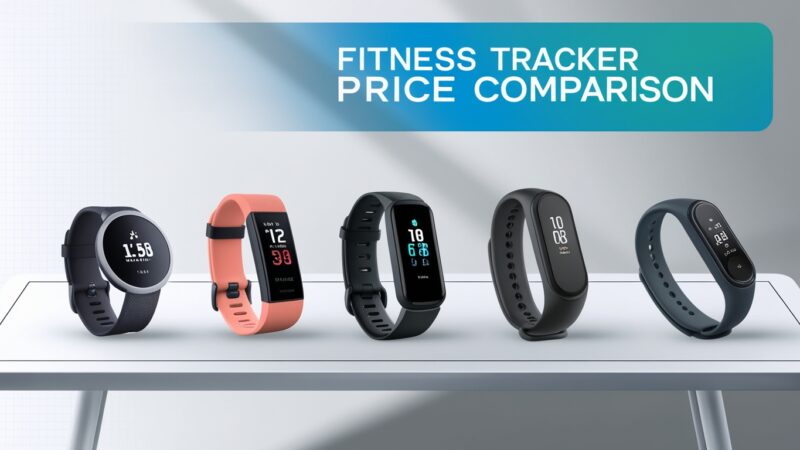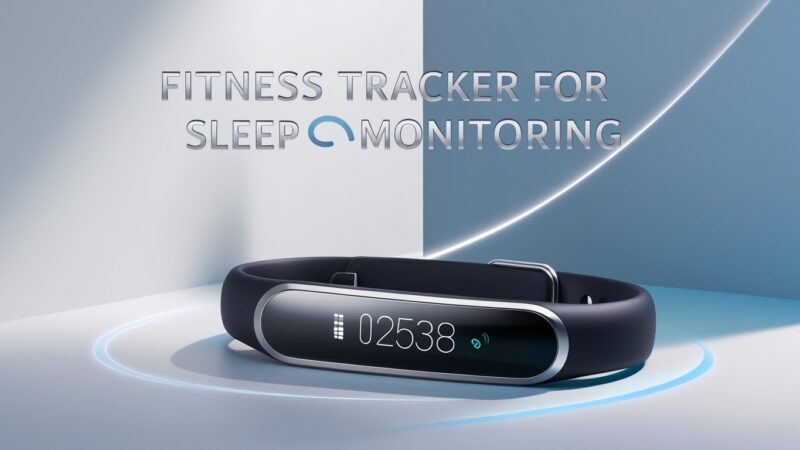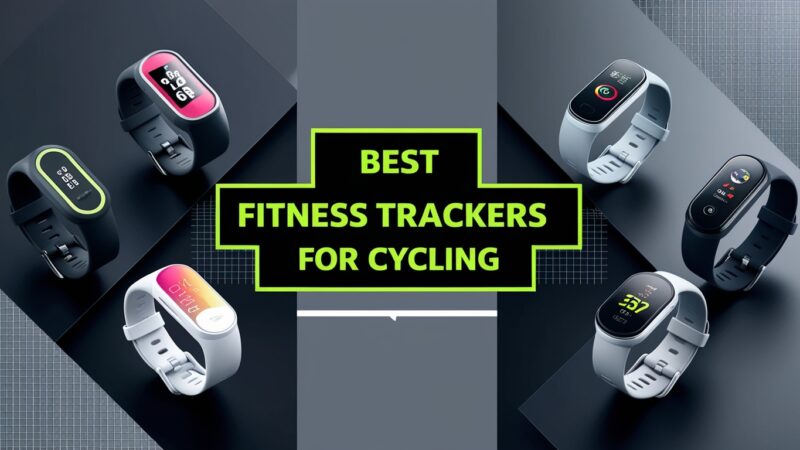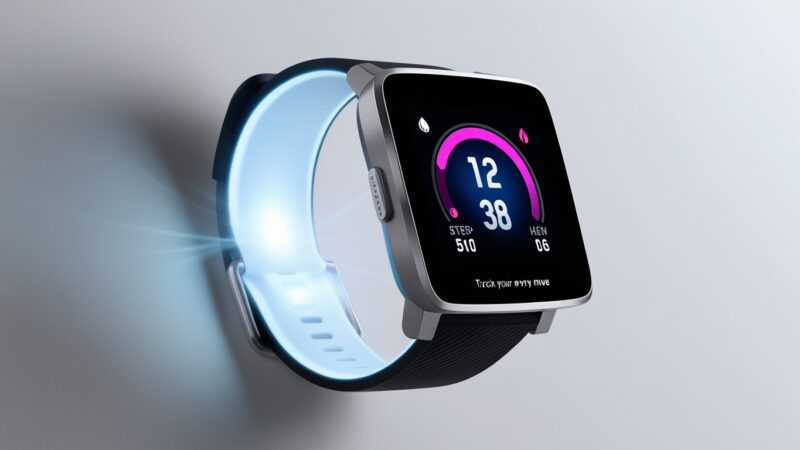Fitness Tracker Features Comparison Guide

Fitness Tracker Features Comparison
Activity Tracking
Fitness trackers these days are packing some serious features for keeping tabs on our physical activities. They’re not just about counting steps anymore; they cover a range of metrics that can help us understand how active we really are. Here’s what many of these devices track:
- Steps Taken: Counts every step, urging us to get moving.
- Distance Traveled: Measures how far we’ve gone during our activities.
- Calories Burned: Keeps a tally on our energy expenditure.
- Workout Intensity: Looks at how hard we’re pushing ourselves during exercises.
Tracking these metrics equips us with the knowledge needed to set fitness goals and smash them.
Heart Rate Monitoring
Heart rate monitoring is a game-changer for fitness enthusiasts. It gives us a window into our cardiovascular health and helps us tailor our training efforts. With fitness trackers featuring built-in heart rate sensors, we can monitor our heart rate at rest and during exercise, offering a better grasp of our body’s performance.
Continuous Heart Rate Monitoring
Some fancy trackers take it a step further with continuous heart rate monitoring. They keep an eye on our heart rate all day long, not just when we’re sweating it out at the gym. This can reveal patterns and trends that inform our overall heart health.
Heart Rate Variability
On top of just tracking heart rate, select trackers also measure heart rate variability (HRV). HRV is basically the time difference between heartbeats, which can give us insights into our stress levels and recovery. Understanding HRV can help fine-tune our training strategies.
Sleep Tracking
Getting good sleep is key to overall health, and fitness trackers have become brilliant at monitoring our sleep quality. By keeping tabs on our movements, heart rate, and other biometric data while we sleep, these gadgets help us tune our sleep habits for better health.
Sleep Stages
Some fitness trackers are now savvy enough to identify different sleep stages like light, deep, and REM sleep. Knowing how long we’re in each stage can educate us on ways to enhance sleep quality.
Sleep Efficiency
Besides stages, these trackers also analyze sleep efficiency, revealing the percentage of time spent actually sleeping. This is a handy metric for sorting out our sleep habits and pinpointing potential improvements.
GPS and Mapping
If you love outdoor workouts, like running, cycling, or hiking, GPS features in fitness trackers are a big plus. With built-in GPS, these devices can track our route, distance, and even our pace, plus offer real-time feedback on our performance.
Route Tracking
By logging our routes, these trackers provide detailed maps of our previous workouts. This insight comes in super handy for runners and cyclists looking to evaluate progress.
Elevation Tracking
Some trackers even sport altimeters to measure how much elevation we gain during workouts. This information is gold for hikers and mountain bikers keen to understand the terrain they’re conquering.
Smartphone Connectivity
Nowadays, many fitness trackers allow for seamless Smartphone connectivity. This means we can check our data, get notifications, and even control our music without having to dig into our bags.
App Integration
With companion apps, these trackers let us view our health data, set goals, and track progress over time. Plus, many of these apps work nicely with other health and fitness platforms, creating a fuller picture of our well-being.
Notifications and Alerts
Fitness trackers equipped with smartphone connectivity can keep us updated with notifications, including calls, messages, and social media alerts. This way, we can stay connected without being glued to our phones.
All of these features from fitness trackers highlight their impressive capabilities. From tracking a myriad of activities to heart monitoring and refined sleep analyses, these gadgets are essential for anyone aiming to boost their health and fitness. Understanding the unique features offered by various fitness trackers can help us make informed choices that align with personal fitness endeavors.
Tracking Metrics for Improved Fitness
Unlocking Fitness Potential with Comprehensive Tracking
With more and more folks focused on health, fitness trackers have stepped up their game. These wearables provide a treasure trove of data, empowering users to make smart choices and hit their goals. By looking closely at the different metrics these handy devices track, we can unlock the keys to our full potential.
Heart Rate Monitoring: The Pulse of Fitness
Heart rate is one of the most important metrics tracked by fitness trackers. By keeping tabs on our heart rate, we glean vital information about our heart health and workout intensity. For example:
- Resting Heart Rate: Indicates overall fitness level.
- Exercise Fluctuations: Helps tailor workout intensity.
Plus, with some advanced trackers offering HRV analysis, we can learn more about our stress and recovery, allowing for smarter training and lifestyle choices.
Step Counting and Activity Tracking: Quantifying Your Movement
Another core function of fitness trackers is tracking step counts. Keeping an eye on daily steps gives us great insight into our activity levels, allowing us to set achievable goals for moving more. Many devices also recognize and categorize different types of activities, providing robust data for various physical exercises.
Sleep Monitoring: The Restorative Power of Rest
Sufficient sleep is as critical as physical activity. Modern fitness trackers offer excellent sleep tracking features to assess patterns, duration, and quality. By understanding our sleep habits, we can make changes that ensure we get enough rest to support our fitness goals.
Calorie Tracking and Nutrition Monitoring
Fitness trackers are also branching out to track calories and nutrition. Many can connect with apps or even let us log food data manually. This overall picture can be pivotal in crafting effective diet plans and maintaining healthy body weight.
Goal Setting and Progress Tracking
Fitness trackers shine when it comes to setting and tracking personal goals. Many devices let us set personalized targets, whether it’s step count, active minutes, or calorie burn, and provide immediate feedback on our progress. It’s a motivating force guiding us to keep pushing our limits.
Integrating Fitness Tracker Data with Comprehensive Platforms
To maximize fitness tracking, some users sync their devices with comprehensive health platforms or apps. These systems often yield advanced analytics and personalized recommendations and open up social connections with like-minded folks. Pairing fitness data together allows for a more holistic view of our health, helping us make informed decisions to reach our goals.
The rich metrics tracked by modern fitness trackers are changing the game in health and fitness. By diving into the insights these devices deliver, we can better understand our bodies, optimise training and recovery, and start transformative journeys toward better well-being.
Understanding Sensor Technology in Fitness Trackers
Sensor Technology in Fitness Trackers: Unlocking the Power of Data
As the tech surrounding fitness and health tracking grows, we’re seeing some truly sophisticated sensor technology at work in fitness trackers. This tech helps us get deeper insights into physical activity, sleep, and overall wellness.
Accelerometer: The Motion Maestro
The accelerometer is a cornerstone sensor in fitness trackers. It picks up on our movement and acceleration, helping the device detect a broad array of activities — everything from counting steps to gauging workout intensity. By interpreting acceleration patterns, fitness trackers differentiate between various movements to provide detailed activity stats.
Gyroscope: The Orientation Orchestrator
The gyroscope works hand-in-hand with the accelerometer to track orientation and direction changes. This cooperation allows for accurate monitoring of diverse activities like running, cycling, and swimming.
Heart Rate Monitoring: The Pulse of Fitness
We can’t overlook heart rate monitoring in modern fitness trackers. Optical heart rate sensors use light to detect changes in blood flow at the skin surface. This helps track our heart rate in real-time, shedding light on cardiovascular health and exercise intensity.
Sleep Tracking: The Slumber Savant
Fitness trackers have become adept at monitoring sleep. Using advanced algorithms alongside various sensors, they can sort through sleep stages, assessing light, deep, and REM sleep. This data helps improve our understanding of sleep quality and duration.
GPS and Location Tracking: The Navigation Nexus
Outdoor wellness activities have been revolutionized by GPS tech in fitness trackers. GPS allows us to track our location, distance covered, and pace during activities, making the devices invaluable for outdoor enthusiasts.
Altimeter: The Elevation Expert
Fitness trackers equipped with altimeters can measure changes in air pressure to assess elevation. This insight becomes essential for activities like hiking, where elevation gain is a critical metric.
Integrated Sensors: The Synergistic Approach
What truly amplifies the power of fitness trackers is how they integrate various sensors. By combining multiple data sources, the trackers form a rounded view of our activities, health, and wellness. This holistic understanding boosts our ability to make informed decisions about our journeys.
As technology continues to march forward, we can expect fitness trackers to gain even more in-depth tracking capabilities, providing personalised insights into our well-being.
Selecting the Right Fitness Tracker for Your Needs
Understanding Your Fitness Tracking Needs
Choosing the right fitness tracker kicks off with knowing what you need. Are you a running enthusiast aiming to track pace and distance? Perhaps weight training is your thing, and you need a device that can log those sessions. Or maybe you’re just keen on staying active and want something to manage your overall activity level. Identifying what’s most important narrows down the vast options out there.
Comparing Fitness Tracker Features
Fitness trackers come loaded with different features. Here’s a glimpse at some key offerings:
- Activity Tracking: Monitors steps, distance, and calories burned. Some devices break down specific activities.
- Heart Rate Monitoring: Built-in sensors give real-time heart rate data during workouts and day-to-day.
- Sleep Tracking: Tracks sleep patterns, including timing for light, deep, and REM sleep.
- Smart Features: Certain models let you receive notifications, control music, or even make payments.
Choosing the Right Fitness Tracker for Your Budget
Fitness trackers vary in price, typically running from around £40 to over £250. When picking one, consider your budget alongside the features that matter most to you.
Budget-Friendly Options
If funds are tight, don’t worry; plenty of affordable fitness trackers offer feature sets that still deliver valuable stats about your activity levels and health.
Premium Fitness Trackers
If you’re flexible with spending, you might explore high-end models that boast comprehensive features like advanced heart rate tracking, GPS capability, and connectivity with various smart devices and apps.
Factors to Consider When Choosing a Fitness Tracker
In addition to features and budget, keep these pointers in mind when selecting a fitness tracker:
- Compatibility with Your Devices: Ensure the fitness tracker syncs smoothly with the smartphone or tablet you own.
- Water Resistance: Look for a water resistance rating of at least 5 ATM (50 meters) if you’ll be using the tracker for swimming or other water activities.
- Battery Life: Think about battery life; few want to charge their devices every night. Some can last for days without needing a reboot.
- Design and Comfort: The tracker should fit comfortably and match your style, as you’ll wear it daily.
By reflecting on your unique needs, key features, budget, and other important elements, you’ll find the ideal fitness tracker geared up to help you smash those health and wellness targets.
Integrating Fitness Tracker Data into Wellness Programs
Unlocking the Power of Fitness Tracker Data for Wellness Programs
In our health-focused society, fitness trackers are now essential tools for monitoring our physical activities, sleep, and well-being. As these devices keep evolving, they show incredible potential for reshaping wellness programs. By merging fitness tracker data into wellness initiatives, organizations can tap into a treasure trove of insights that can help create more personalized, efficient programs.
Personalized Wellness Strategies
Using fitness tracker data allows wellness programs to tailor recommendations for individual participants. With a complete overview of activity levels, sleep quality, and other health metrics, coordinators can pinpoint focus areas for improvement. This data-driven approach leads to custom strategies that tackle participants’ unique challenges, boosting engagement and outcomes.
Continuous Monitoring and Feedback
Fitness trackers enable continuous monitoring of participants’ progress, providing real-time insights that help refine wellness programs. By tracking changes in activity, sleep, and other metrics, coordinators can readily spot where participants need help and adjust their plans accordingly. This ongoing feedback loop creates a responsive approach to wellness, empowering people to actively engage in their health.
Gamification and Motivation
Integrating fitness tracker data can also harness gamification elements to amp up participation and motivation. By adding features like step challenges, leaderboards, and virtual rewards, wellness programs can capitalize on our competitive spirit. This fun approach keeps participants focused, builds a community, and encourages healthy habits that seamlessly integrate into daily life.
Data-Driven Decision Making
Beyond individual insights, compiling fitness tracker data across a wellness program offers valuable information for administrators. By analyzing trends within participant populations, coordinators can seek improvements, allocate resources wisely, and make informed decisions to elevate their initiatives.
Overcoming Challenges
Although integrating fitness tracker data into wellness programs brings substantial benefits, addressing concerns related to privacy and potential challenges is crucial. Ensuring data security, obtaining consent, and tackling ownership issues are vital considerations. Wellness coordinators must also keep in mind that fitness tracker data, while useful, does not always paint a complete picture of an individual’s health.
Toward a Holistic Approach
As fitness trackers become more widespread, incorporating their data into wellness programs signifies an exciting chance to develop more tailored, engaging initiatives. By tapping into the power of fitness tracker data, organizations can take a holistic view of participant wellness, driving better physical and mental health outcomes while contributing to the overall success of their programs.
You can now buy my E-Book on Discount for only $4! If you need personal help or a program, you can reach out to me on Instagram!
Fitness Tracker Features Comparison: What’s New?
Enhanced Activity Tracking
Fitness trackers have upped their game in recent months. New models now come with enhanced activity tracking features that offer more detailed insights:
- Exercise Recognition: Many devices use machine learning to automatically recognize various forms of exercises such as running, swimming, and cycling, making logging more effortless.
- Stress Tracking: Some fitness trackers now assess stress levels based on heart rate variability and activity levels, helping us manage stress better.
- Activity Reminders: As a gentle nudge to keep us moving throughout the day, some trackers send reminders to stand or move after prolonged inactivity.
Improved Heart Rate Monitoring
While heart rate monitoring is not new, recent innovations have made it more robust:
- Advanced Algorithm Technology: Trackers are now utilizing more sophisticated algorithms to enhance accuracy in heart rate readings, especially during intense workouts. For instance, devices can now differentiate between cardiovascular and strength training exertion levels.
- SpO2 Monitoring: Some devices also monitor blood oxygen saturation levels (SpO2), providing insights into respiratory health, which is particularly valuable for high-altitude training or understanding recovery status.
Next-Gen Sleep Tracking
Recent additions to sleep tracking capabilities offer greater insights than ever before:
- Sleep Disruption Alerts: New features can alert us to sleep disturbances like snoring or restlessness detected during the night!
- Temperature Regulation: Certain trackers now include body temperature tracking to assess if fluctuations could potentially impact sleep quality.
- Sleep Coaching: Some apps connected to trackers now offer tailored coaching to improve sleep hygiene, including suggestions based on sleep patterns.
GPS Accuracy and Routing
For those who enjoy outdoor activities, improved GPS features are making a significant impact:
- Multi-GNSS Support: Advanced models now support multiple Global Navigation Satellite Systems (GNSS) for improved accuracy in tracking locations whether in challenging terrains or urban settings.
- Real-Time Route Sharing: Some devices allow users to share their real-time route with others for safety during outdoor workouts.
- Offline Maps: A few trackers now come equipped with downloaded maps, so you can navigate even without cellular service, perfect for hiking or camping.
Integrated Health Features
Fitness trackers are evolving beyond just fitness metrics to include more holistic health monitoring:
- Hydration Tracking: Some devices now allow users to log their daily water intake, reminding them to stay hydrate.
- Nutrition Logging: Integration with nutrition tracking apps provides users with the ability to input meals and snacks for a complete snapshot of overall health and fitness.
- Mental Well-Being Metrics: Features that analyze mood and mental health have emerged, encouraging users to reflect on their emotional state.
Functionality and Design
The design of fitness trackers is also seeing innovation, making them more user-friendly:
- Customizable Watch Faces: Many models now offer interchangeable and customizable settings for watch faces, allowing personalization based on user preference.
- Enhanced Battery Life: Newer devices are reported to extend battery life significantly, lasting multiple days to weeks, even under extensive use.
- More Robust Materials: Advances in materials are leading to increased durability and waterproof ratings, so they can withstand more intense activities.
In summary, the landscape of fitness trackers is continually shifting, with more sophisticated features coming into play. The Fitness Tracker Features Comparison landscape is not just about tracking our activities; it’s about a holistic approach to health that empowers us with data, insights, and motivation. Fitness trackers are smarter, more accurate, and more integrated into our overall health routines than ever. Understanding these new features can help us select the right fitness tracker for our unique needs and elevate our fitness journeys.
For more information, explore our website. You can find answers to common questions in our FAQ section, learn more about us on our Home page, discover the range of services we offer in the What We Provide section, get in touch with us through the Contact page, and stay connected with us on our Socials.
You can now buy my E-Book on Discount for only $4! If you need personal help or a program, you can reach out to me on Instagram!






